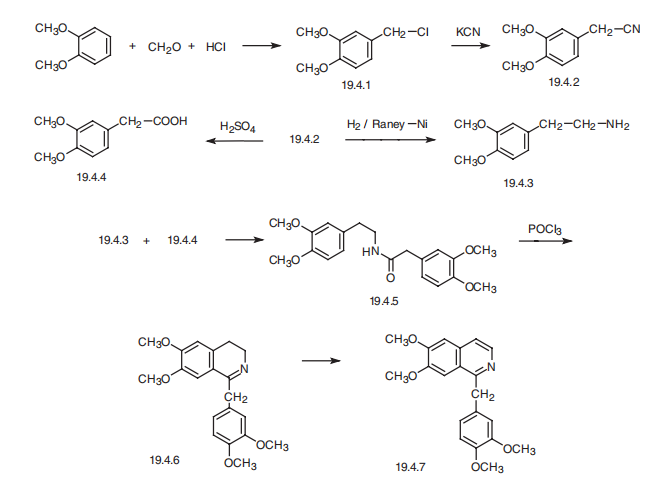| Identification | Back Directory | [Name]
PAPAVERINE HYDROCHLORIDE | [CAS]
58-74-2 | [Synonyms]
S-M-R
Papacon
Papaveri
Robaxapap
Papalease
papaverin
papanerin
Papanerine
PAPAVERINE
Papaverina
AKOS 220-12
PAPAVERINE HCL
Papaverine,99%
Papanerin-HCl [German]
18) META CHLORO BENZALDEHYDE
6,7-dimethoxy-1-veratryl-isoquinolin
6,7-Dimethoxy-1-veratrylisoquinoline
Isoquinoline, 6,7-dimethoxy-1-veratryl-
6,7-DIMETHOXY-1-VERATRYLISOQUINOLINE HCL
6,7-DIMETHOXY-1-VERATRYL-ISOQUINOLINE HYDROCHLORIDE
1-(3,4-DIMETHOXY-BENZYL)-6,7-DIMETHOXY-ISOQUINOLINE
1-((3,4-dimethoxyphenyl)methyl)-6,7-dimethoxy-isoquinolin
1-((3,4-Dimethoxyphenyl)methyl)-6,7-dimethoxyisoquinoline
isoquinoline, 1-[(3,4-dimethoxyphenyl)methyl]-6,7-dimethox
Isoquinoline, 1-[(3,4-dimethoxyphenyl)methyl]-6,7-dimethoxy-
1-[(3',4'-DIMETHOXYPHENYL)METHYL]-6,7-DIMETHOXYISOQUINOLINE HCL | [EINECS(EC#)]
200-502-1 | [Molecular Formula]
C20H22ClNO4 | [MDL Number]
MFCD00012745 | [MOL File]
58-74-2.mol | [Molecular Weight]
375.85 |
| Chemical Properties | Back Directory | [Melting point ]
226 °C
| [Boiling point ]
475.36°C (rough estimate) | [density ]
d420 1.337 | [refractive index ]
1.6250 (estimate) | [solubility ]
H2O: 25 mg/mL
| [form ]
powder
| [pka]
6.4(at 25℃) | [color ]
white
| [Water Solubility ]
37.33mg/L(37.5 ºC) | [Merck ]
14,7019 | [BRN ]
312930 |
| Hazard Information | Back Directory | [Uses]
folate metabolic inhibitor, coccidiostat | [Uses]
muscle relaxant (smooth), cerebral vasodilator | [Uses]
opium alkaloid | [Definition]
ChEBI: A benzylisoquinoline alkaloid that is isoquinoline substituted by methoxy groups at positions 6 and 7 and a 3,4-dimethoxybenzyl group at position 1. It has been isolated from Papaver somniferum. | [Chemical Properties]
White crystalline powder; obtained asorthorhombic prisms from an alcohol–ethermixture; melts at 147°C (296.6°F); sublimesunder vacuum; insoluble in water; soluble inacetone, glacial acetic acid, and benzene. | [Originator]
Lempav Ty-Med ,Lemmon,US,1975 | [Indications]
Papaverine (Pavabid) is a nonspecific phosphodiesterase
inhibitor that increases cAMP and cGMP levels
in penile erectile tissue. Papaverine is particularly
known as a smooth muscle relaxant and vasodilator. Its
principal pharmacological action is as a nonspecific vasodilator
of smooth muscles of the arterioles and capillaries.
Various vascular beds and smooth muscle respond
differently to papaverine administration both in
intensity and duration. Papaverine decreases the resistance
to arterial inflow and increases the resistance to
venous outflow. | [Manufacturing Process]
To 3.65 g (0.01 mol) of monohydrated adenosine-5'-monophosphoric acid, brought into suspension in a mixture of 45 ml of water and 5 ml of ethanol, are added 339 g (0.01 mol) of papaverine base (melting point, 147°C). The mixture is gently heated until a final temperature of 40°C is reached. The solution obtained is then filtered and the filtrate is concentrated under vacuum. The remaining product quickly crystallizes. After drying to 50°C to constant weight, there are obtained 6.68 g of desired product, in the monohydrated state, as a white crystalline powder, which melts at 140°C and is very soluble in water.
| [Brand name]
Pavabid (Hoechst Marion Roussel). | [Therapeutic Function]
Vasodilator, Platelet aggregation inhibitor | [Health Hazard]
Papaverine is an inhibitor of cyclic nucleotidephosphodiesterase, producing vasodilatoryeffect. The acute toxic effects relative tophenanthrene-type opium alkaloids (e.g.,morphine, heroin) are low and the symptomsare not the same. Papaverine is neither a narcoticnor an addictive substance. Excessivedoses may produce drowsiness, headache,facial flushing, constipation, nausea, vomiting,and liver toxicity.
The LD50 data reported in the literatureshow variation. An oral LD50 value in rats ison the order of 400 mg/kg. | [Mechanism of action]
When administered by intracavernosal injection, papaverine, a weak and nonspecific PDE inhibitor, is thought to cause relaxation of the cavernous smooth muscles and vasodilation of the penile arteries by inhibition of PDE. These effects result in increased arterial blood flow into the corpus cavernosa and in swelling and elongation of the penis. Venous outflow also is reduced, possibly as a result of increased venous resistance. | [Clinical Use]
Papaverine is highly effective in men with psychogenic
and neurogenic ED but less effective in men
with vasculogenic ED. Papaverine–phentolamine combinations
have been used in self-injection procedures.
Papaverine doses may range from 15 to 60 mg. Papaverine
treatment in patients with severe arterial or venous
incompetence is usually unsuccessful, but autoinjections
using low doses sufficient to achieve an erection
are safe and efficient. | [Side effects]
Major side effects associated with papaverine therapy
include priapism, corporeal fibrosis, and occasional
increases in serum aminotransferases. Intracorporeal
scarring may be related to the low pH of the vehicle that
is necessary to solubilize papaverine.Attempts to buffer
papaverine to render it more suitable for intracavernosal
injection have not been entirely satisfactory, and
such delivery may still lead to intracorporeal scarring. | [Synthesis]
Papaverine, 1-veratryl-6,7-dimethoxyisoquinolin (19.4.7), is synthesized
from veratrol. Veratrol undergoes chloromethylation, forming 3,4-dimethoxybenzylchloride
(19.4.1). Reacting this with potassium cyanide gives 3,4-dimethoxybenzylcyanide (19.4.2).
The resulting 3,4-dimethoxybenzylcyanide undergoes reduction by hydrogen over Raney
nickel, forming homoveratrylamine (19.4.3). At the same time 3,4-dimethoxybenzylcyanide
(19.4.2) undergoes acidic hydrolysis giving 3,4-dimethoxyphenylacetic acid
(19.4.4). The interaction of the resulting compounds brings to corresponding amide
(19.4.5). The cyclization of this by Bischler¨CNapieralski method, using phosphorous oxychloride,
gives 3,4-dihydropapaverine (19.4.6), which is dehydrated into the desired papverine
when heated in tetraline at high temperatures.
|
| Safety Data | Back Directory | [Hazard Codes ]
Xn | [Risk Statements ]
22 | [Safety Statements ]
22 | [RIDADR ]
UN 1544 6.1/PG 3
| [WGK Germany ]
1
| [RTECS ]
NW8575000
| [F ]
8 | [HazardClass ]
6.1(a) | [PackingGroup ]
II | [Safety Profile]
Poison by ingestion, intramuscular, subcutaneous, intradermal, intraperitoneal, and intravenous routes. Human systemic effects: coma, somnolence. Its central nervous system action is about midway between those of morphme and codeine, and large doses do not produce the amount of excitement caused by codeine or the soporific action of morphine. Mutation data reported. A cerebral vasodilator and smooth muscle relaxant. Combustible when exposed to heat or flame. When heated to decomposition it emits toxic fumes of NOx. See also MORPHINE. | [Hazardous Substances Data]
58-74-2(Hazardous Substances Data) | [Toxicity]
LD50 orl-rat: 325 mg/kg ARZNAD 20,1338,70 |
|